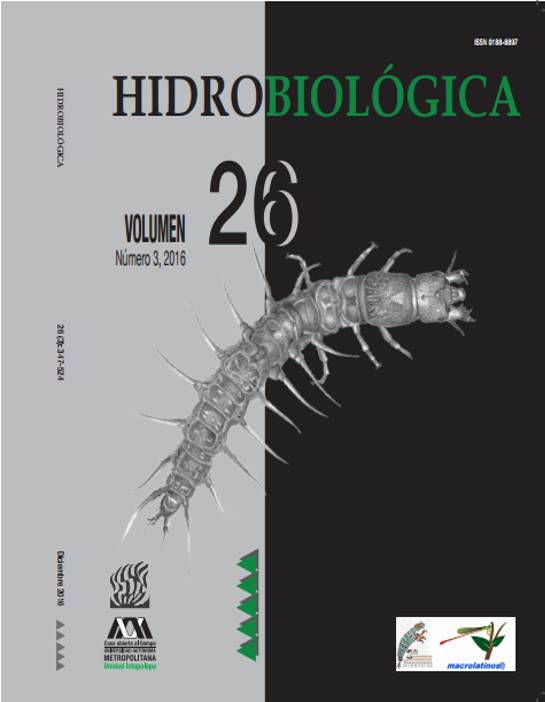Aquatic macroinvertebrates assemblages related to diverse land uses in the Apatlaco and Chalma-Tembembe rivers (Balsas basin), Mexico
DOI:
https://doi.org/10.24275/uam/izt/dcbs/hidro/2016v26n3/LopezKeywords:
Aquatic invertebrates, bioindication, catchment area, land use, tropical riversAbstract
Background. Rivers are considered as integrators systems reflecting physicochemical and biological processes that take place in its catchment area and have a constant flow of matter and energy. This is due to its connectivity and interactions with its watershed and the atmosphere. The Apatlaco and Chalma-Tembembe rivers (Balsas River basin) have different levels of disturbance, caused by changes in land use (US) in its watershed. Goals. To analyze the relationships of the physico-chemical characteristics of water and aquatic macroinvertebrates (AI) assemblages with different US adjacent to Apatlaco and Chalma-Tembembe rivers. Methods. In both rivers, water samples (20 sites studied) and AI were taken for four seasons, and the percentage of US corresponding to their area of impact was determined. Ordination analysis, similarity and Pearson correlation (p <0.05), with the physicochemical parameters, biological and US were performed. Results. The river Apatlaco presented the higher alterations due to the combination of US, with a high percentage of urban use; Chalma-Tembembe showed more homogeneous physicochemical and biological characteristics. Conclusions. Some assemblage of macroinvertebrates families were correlated with healthy ecosystems (Belostomatidae, Cordulegastridae, Corixidae, Corydalidae, Dryopidae, Elmidae, Hebridae, Helicopsychidae, Heptageniidae, Hydrobiosidae, Lepidostomatidae, Libellulidae, Perlidae, Philopotamidae, Polycentropodidae, Scirtidae, Staphilinidae and Tabanidae); while others with highly disturbed environments (Ancylidae, Asellidae, Chironomidae, Hyalellidae, Psychodidae and Class Hirudinea); and sites impacted by agricultural activities were correlated with moderate abundances and low diversity of AI.Downloads
Downloads
How to Cite
Issue
Section
License
Los autores/as que publiquen en esta revista aceptan las siguientes condiciones:
De acuerdo con la legislación de derechos de autor, HIDROBIOLÓGICA reconoce y respeta el derecho moral de los autores, así como la titularidad del derecho patrimonial, el cual será cedido a la revista para su difusión en acceso abierto.
Publicar en la revista HIDROBIOLÓGICA tiene un costo de recuperación de $500 pesos mexicanos por página en blanco y negro (aproximadamente 29 dólares americanos) y $1000 pesos por página a color (aproximadamente 58 dólares americanos).
Todos los textos publicados por HIDROBIOLÓGICA sin excepción se distribuyen amparados bajo la licencia Creative Commons 4.0Atribución-No Comercial (CC BY-NC 4.0 Internacional), que permite a terceros utilizar lo publicado siempre que mencionen la autoría del trabajo y a la primera publicación en esta revista.
Los autores/as pueden realizar otros acuerdos contractuales independientes y adicionales para la distribución no exclusiva de la versión del artículo publicado en HIDROBIOLÓGICA (por ejemplo incluirlo en un repositorio institucional o publicarlo en un libro) siempre que indiquen claramente que el trabajo se publicó por primera vez en HIDROBIOLÓGICA.
Para todo lo anterior, el o los autor(es) deben remitir el formato de Carta-Cesión de la Propiedad de los Derechos de la primera publicación debidamente requisitado y firmado por el autor(es). Este formato se puede enviar por correo electrónico en archivo pdf al correo: enlacerebvistahidrobiológica@gmail.com; rehb@xanum.uam.mx (Carta-Cesión de Propiedad de Derechos de Autor).
Esta obra está bajo una licencia de Creative Commons Reconocimiento-No Comercial 4.0 Internacional.


